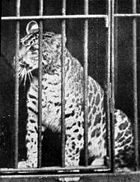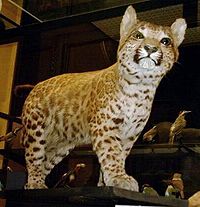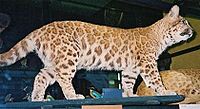
Pumapard
Encyclopedia



Leopard
The leopard , Panthera pardus, is a member of the Felidae family and the smallest of the four "big cats" in the genus Panthera, the other three being the tiger, lion, and jaguar. The leopard was once distributed across eastern and southern Asia and Africa, from Siberia to South Africa, but its...
. Both male puma with female leopard and male leopard with female puma pairings have produced offspring. In general, these hybrids have exhibited a tendency to dwarfism
Dwarfism
Dwarfism is short stature resulting from a medical condition. It is sometimes defined as an adult height of less than 4 feet 10 inches , although this definition is problematic because short stature in itself is not a disorder....
.
Reported Puma/Leopard Hybrids
In the late 1890s/early 1900s, two hybrids were born in ChicagoChicago
Chicago is the largest city in the US state of Illinois. With nearly 2.7 million residents, it is the most populous city in the Midwestern United States and the third most populous in the US, after New York City and Los Angeles...
, USA followed 2 years later by three sets of twin cubs born at a zoo in Hamburg
Hamburg
-History:The first historic name for the city was, according to Claudius Ptolemy's reports, Treva.But the city takes its modern name, Hamburg, from the first permanent building on the site, a castle whose construction was ordered by the Emperor Charlemagne in AD 808...
, Germany
Germany
Germany , officially the Federal Republic of Germany , is a federal parliamentary republic in Europe. The country consists of 16 states while the capital and largest city is Berlin. Germany covers an area of 357,021 km2 and has a largely temperate seasonal climate...
from a puma father and leopard mother. Carl Hagenbeck apparently bred several litters of puma x leopard hybrids in 1898 at the suggestion of a menagerie owner in Britain
United Kingdom
The United Kingdom of Great Britain and Northern IrelandIn the United Kingdom and Dependencies, other languages have been officially recognised as legitimate autochthonous languages under the European Charter for Regional or Minority Languages...
; this was possibly Lord Rothschild (as one of the hybrids is preserved in his museum) who may have heard of the two hybrid cubs bred in Chicago in 1896 and suggested Hagenbeck reproduced the pairing.
Hagenbeck's puma/leopard hybrids may have been inspired by a pair of leopard x puma hybrid cubs born in Chicago on 24 April 1896 at Tattersalls indoor arena where Ringling Brothers Circus opened its season. Details about the two cubs were published in The Chicago Chronicle on 25 April 1896: Two tiny cubs which look like young leopards were born at Tattersall's where Ringling Brothers circus is housed, yesterday (24 APR [18]96). They are not leopards, however. Their mother is a mountain lion or cougar and their father is a leopard. They take after their father decidedly, and are the daintiest little members of the cat family ever born in captivity. In fact they are the only ones of their kind, so far as known, ever born, either within the confines of a cage or anywhere else. These black and yellow youngsters were on exhibition yesterday and were admired by all who saw them. They will probably be on view the rest of the time the circus exhibits in Chicago.
A similar hybrid was reported by Helmut Hemmer. These hybrids had Puma-like long tails and sandy or tawny coats with chestnut Leopard-like markings and Puma-like cheek markings. Another was described as resembling a little grey Puma with large brown rosettes.
In The Field No 2887, April 25, 1908, Henry Scherren wrote "There was, and probably is now, in the Berlin Garden an Indian leopard and a puma male hybrid, purchased of Carl Hagenbeck in 1908. In his "Guide", Dr Heck described it as "a little grey puma with large brown rosettes." Another hybrid between the same species, but with a puma for sire and a leopard for dam, was recently at Stelingen; it resembled the female parent in form as may be seen From the reproduction from a photograph taken there."
According to Carl Hagenbeck (1951), a male Puma and female Leopard produced a hybrid male cub that was reared by a Fox Terrier
Fox Terrier
Fox Terrier refers primarily to two different breeds of the terrier dog type: the Smooth Fox Terrier and the Wire Fox Terrier. Both of these breeds originated in the 19th century from a handful of dogs who are descended from earlier varieties of British terriers, and are related to other modern...
bitch at Hagenbeck Tierpark, Hamburg (fostering being normal practice at this time). This male hybrid was intermediate between the Puma and Leopard in colour and pattern, having faint Leopard spots on a Puma-coloured background. The body length was much less than either parent while the tail was long, like the Puma. A further male hybrid from a mating of male Leopard and female Puma was described as a little grey puma with large brown rosettes. Hagenbeck apparently bred these hybrids at the suggestion of an unidentified menagerie owner, however, the hybrids were considered dull and uninteresting. Modern geneticists find them more interesting because the Leopard and the Puma were not considered to be closely enough related to produce offspring.
H Petzsch (1956) mentioned that Puma/Leopard hybrids had been obtained by artificial insemination. H Hemmer (1966) reported the hybrid between a male Indian Leopard (P pardus fusca) and female Puma as being fairly small with a ground colour like that of the Puma and having rather faded rosettes.
The hybrids were additionally reported by CJ Cornish et al. (undated), R Rörig (1903), T Haltenorth (1936) and O Antonius (1951).
Appearance
Whether born to a female Puma mated to a male Leopard, or to a male Puma mated to a female Leopard, pumapards inherit a form of dwarfism. Those reported grew to only half the size of the parents. They have a Puma-like long body (proportional to the limbs, but nevertheless shorter than either parent) with short legs. The coat is variously described as sandy, tawny or greyish with brown, chestnut or "faded" rosettes.One is preserved in the Walter Rothschild Zoological Museum
Walter Rothschild Zoological Museum
The Natural History Museum at Tring was the private museum of Lionel Walter, 2nd Baron Rothschild, today it is under the control of the Natural History Museum. It houses one of the finest collections of stuffed mammals, birds, reptiles and insects in the United Kingdom...
at Tring
Tring
Tring is a small market town and also a civil parish in the Chiltern Hills in Hertfordshire, England. Situated north-west of London and linked to London by the old Roman road of Akeman Street, by the modern A41, by the Grand Union Canal and by rail lines to Euston Station, Tring is now largely a...
, England
England
England is a country that is part of the United Kingdom. It shares land borders with Scotland to the north and Wales to the west; the Irish Sea is to the north west, the Celtic Sea to the south west, with the North Sea to the east and the English Channel to the south separating it from continental...
and clearly shows the tendency to dwarfism. This hybrid was exhibited at the Tierpark in Stellingen (Hamburg).
The black and white photograph also appeared in Animals of the World (1917) with the caption This is a photograph from life of a very rare hybrid. That animal's father was a puma, its mother a leopard. It is now dead and it may be seen stuffed in Mr. Rothschild's Museum at Tring.
Puma-Ocelot Hybrid
For comparison with the pumapard, a female Puma has also been successfully hybridised with a male OcelotOcelot
The ocelot , pronounced /ˈɒsəˌlɒt/, also known as the dwarf leopard or McKenney's wildcat is a wild cat distributed over South and Central America and Mexico, but has been reported as far north as Texas and in Trinidad, in the Caribbean...
although the hybrids died due to lack of maternal care. In spite of the size difference, several sets of Puma-Ocelot hybrids were born to the same parents who shared an enclosure in a private collection. A subsequent female Ocelot-Puma cub born to the pair apparently survived and is shown at L'Ocelot-Puma. The surviving hybrid appears to be long-legged and intermediate in size between the parents with brown markings on a sandy background.
See also
- Felid hybridFelid hybridThere are a number of hybrids between various felid species. This article deals with hybrids between the smaller felid species and those between smaller felids and Panthera species. For hybrids between two Panthera species see Panthera hybrid.-Servical/caraval:A servical is a cross between a...
s - Ocelot/Puma and other small cat hybrids - Panthera hybridPanthera hybridThe four living species of Panthera genus may produce a number of hybrid crosses...
s - hybrids between lions, tigers, leopards and jaguars

